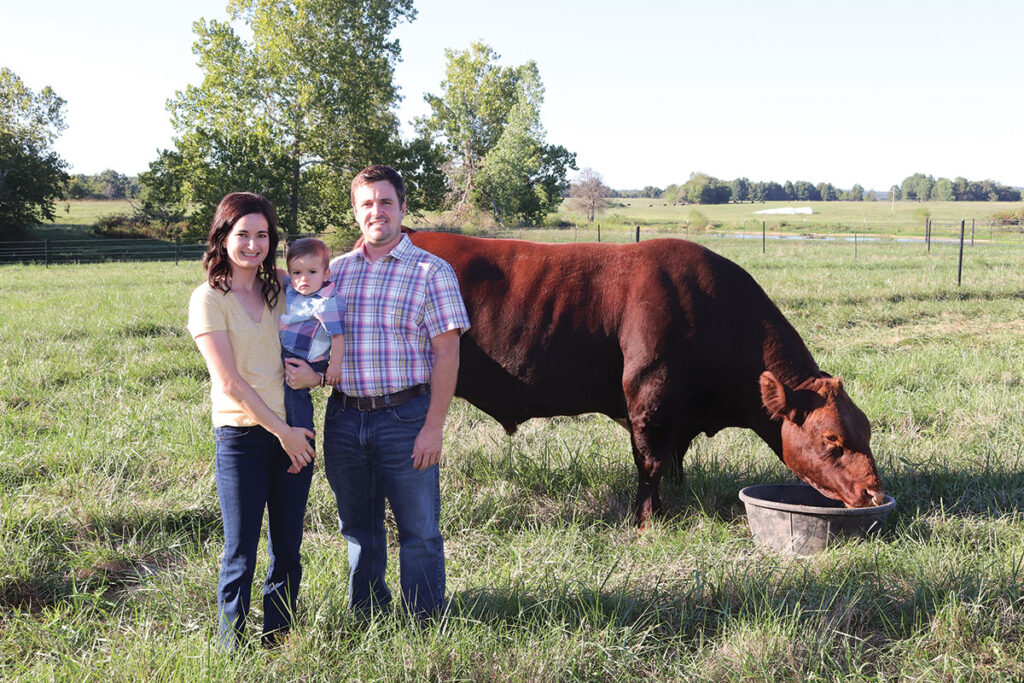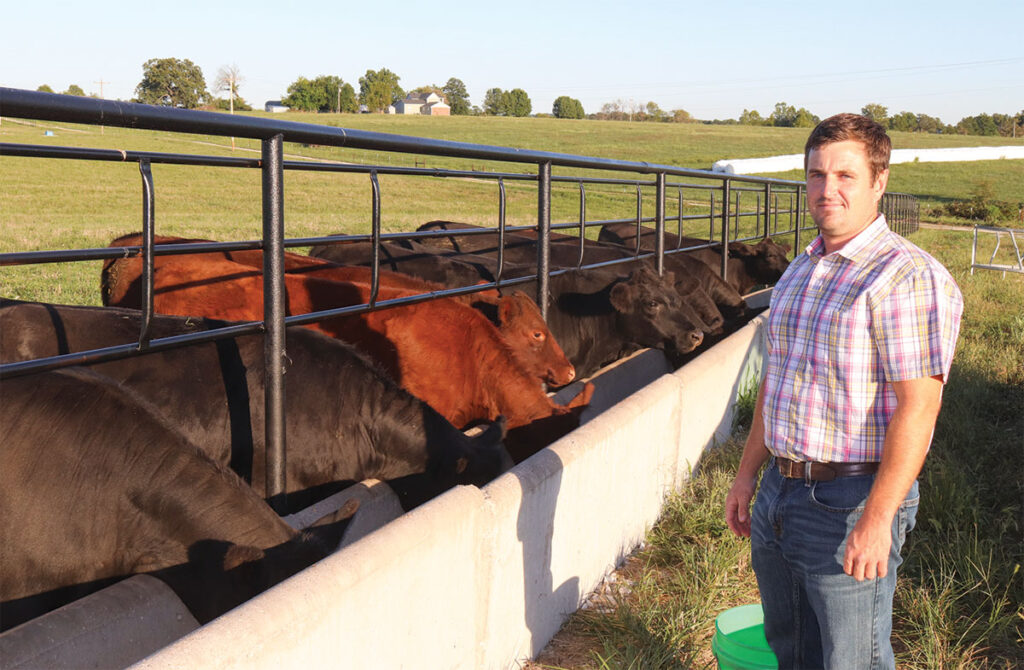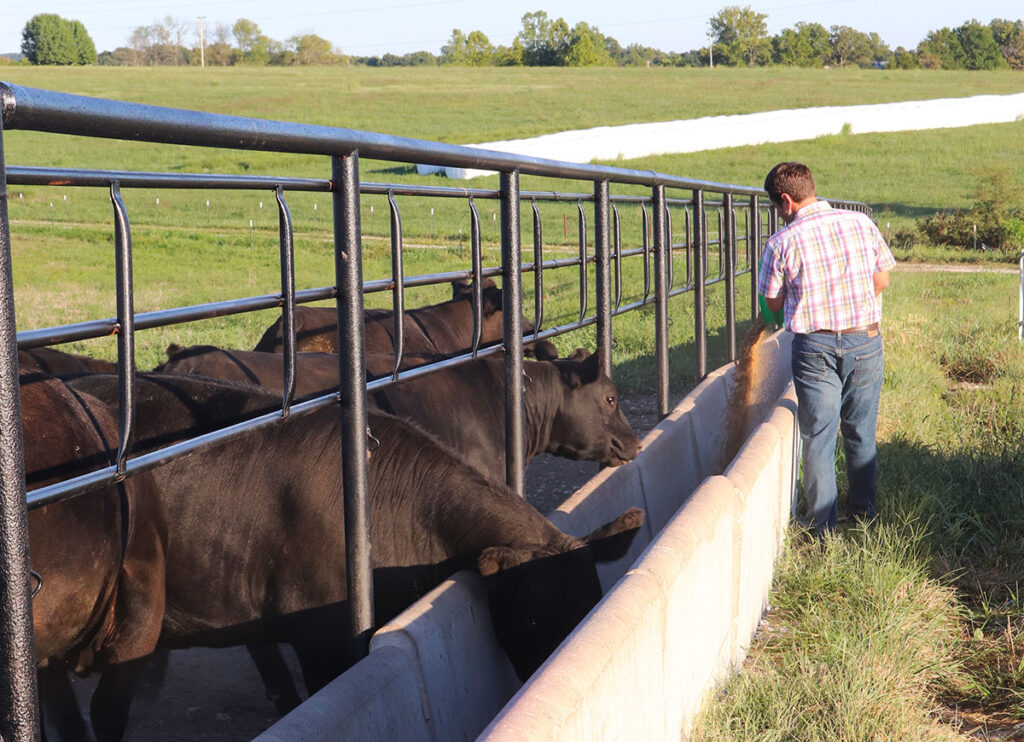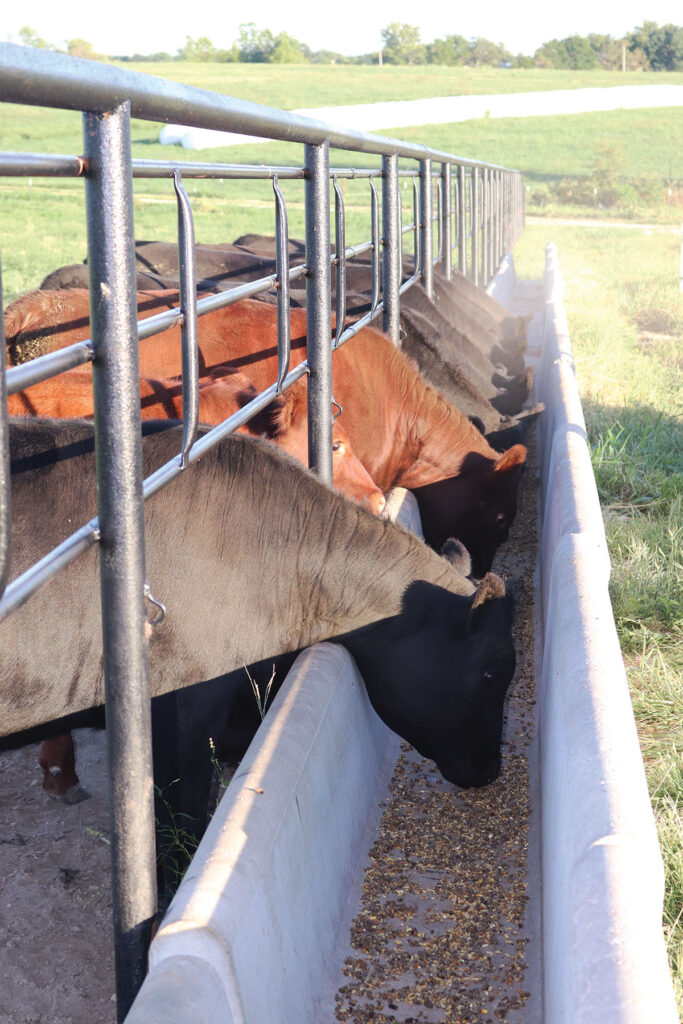
Third-generation cattle producer Brett Naylor and his family breed for high-quality cattle
HALFWAY, MO. – At his Halfway, Mo., farm, Brett Naylor is continuing a family tradition in the cattle business. Brett, his wife Brittney and their 15-month-old son Hudson breed purebred, registered Shorthorn and Angus cattle.
Between their farm and Brett’s parents, Gary and Pam Naylor, there is about 150 head of registered cattle on approximately 600 acres.
Brett and Brittney purchased their Polk County, Mo., farm in 2020.
“My idea was to move closer to Mom and Dad to help them, but they help me more than I help them,” Brett said with a laugh.
Gary and Pam moved to Missouri from Illinois in the 1970s to manage a purebred Shorthorn operation. They eventually purchased their farm near Buffalo to begin raising Shorthorns of their own, the breed Pam’s family raised.
“We’re about 50/50 with the Shorthorn and Angus,” Brett said. The Naylors added Charolais to their Shorthorn operation for several years but moved toward Angus in the late 1990s. “It’s been good for us. I like both breeds; one has a quality or characteristic over the other. If we didn’t feel each had a fit in the beef industry, we wouldn’t have both breeds.”
For the Angus side of the Naylor operation, the breed’s growth, fleshing ability, carcass characteristics, and the demand for black bulls in commercial operations are attributes they admire. As for the Shorthorns, it’s the maternal qualities of the females, quality carcass characteristics that meet or exceed the Angus, and the structure and longevity of the breed. Brett added they have also had great success selling solid red bulls into commercial operations.

Providing high-quality bulls for both seedstock and commercial operations is the focus of Naylor Angus and Shorthorn.
“There are more commercial operations and commercial cows than there are purebred herds,” Brett said. “We want to provide a quality product to those purebred breeders so they can improve their genetics in their herd, but the majority of our customers are commercial operations. They’re looking for a high-quality, purebred bull that is going to produce calves that will grow and cut out with good carcass characteristics. We don’t focus on one over the other; we want to make sure we provide a high-quality product to both types of producers.”
The Naylors begin marketing bulls at birth, offering customers information regarding sires and other data.
“At weaning is when it starts to pick up,” Brett explained. “We don’t keep every bull because not 100 percent of them will make the cut and be up to our standards. We have customers who want to come and pick out bulls as soon as they’re weaned because they want to select out of our herd first; they want to best bull.”
Most bulls are sold between 12 and 16 months of age. Semen from bulls retained by the Naylors is collected for use in their breeding program, and they offer straws to customers.
The Naylors exclusively AI their females. Because they have the two breeds, Brett said AI is critical to ensure the herds remain purebred, but there are also other advantages.
“AI allows you to use a diversity of genetics,” he explained. “If you’re just going out and buying a herd bull and you pick the right one, that’s wonderful because you’ve improved the genetics on your farm. But, if you pick the wrong one, you’ve set yourself back many years. AI allows us to choose a wide array of bulls. Not every bull we choose turns out to be the right one, but you can get your feet wet and use a new bull or two every year. If you pick the right bull, you can decide if you like that bull’s progeny and if you want to use him more in the future. AI allows us to not only maximize our genetic potential but be in the purebred seedstock business as opposed to the commercial crossbred business.”
AI also allows Brett to select specific calving windows, the number of females in each window, and matings based on each female. By having multiple calving cycles, the Naylors can also move females that did not breed in a previous cycle to a later one. About 95 percent of the herd is fall calving.

“We focus on calving ease because you can’t do anything if you don’t have a live calf, so that’s our first criteria in both breeds, especially in our first-calf heifers. After you get a live calf, you worry about everything else,” Brett, who is president of the Missouri Shorthorn Association, said.
The Naylors have done some work with embryo transfer and plan to utilize it more in the future.
“We’re always looking to improve the genetics of our herd and have been buying some select lots the last year or two in different sales,” Brett explained.
In addition to genetics, Brett said it’s essential to look at the whole animal.
“We look at phenotype; an animal has to be quality on foot first. I think balance is key,” he explained. “A lot of herds will only look at EPDs, and a lot of herds will only look at phenotype. You have to blend them because that’s how you’re going to breed a superior animal. If an animal has exceptional EPDs but struggles out in the real world and the field, it doesn’t do you any good. If an animal looks exceptional but doesn’t meet the criteria people want for growth, calving ease or carcass characteristics, it’s not going to suit them.”
The Naylors are “constantly tweaking” their feeding program, and most cattle receive a chopped corn and soy hull mix with corn gluten and distillers.
“We don’t feed the same thing to all of our cattle,” Brett explained. “We have a different mix for mature cows because they don’t need the level of nutrients that a growing heifer or bull would, so we are constantly changing things to find a better program… We like to be at about 13 percent protein, maybe a little higher for growing calves, maybe a little lower for those mature cows.”
Cattle may receive some grain, but the Naylors strive to provide their cattle with quality forages. Brett has implemented a rotational grazing program on his farm and works to improve forages.

“A couple of years ago, we started doing haylage,” Brett said. “The majority of what I feed is wet haylage. I put it in a vertical mixer, add some dry hay and add some supplements. On this farm, that’s what the cows get in the winter, and they do very well with it; they don’t need a whole lot more.”
Brett added that growing calves also do well with the mixture. “Because of that, we’ve been able to reduce the amount of creep feeding we do, which saves on cost without reducing weaning weights and performance.”
The Naylors grow their hay, and Brett said some areas of his farm were previously used for crops. He hopes to utilize those fields to produce a winter crop, such as wheat or rye, and harvest it for high-quality baleage as well.
Because the cattle are not offered large amounts of grain, Brett said they are able to maintain with fewer inputs.
“I tell people if they can do well here and put on weight, and cows keep their flesh, they can do that about anywhere,” Brett said. “It gives our customers a piece of mind that the bulls they buy, they aren’t going to have to baby them. The females they buy are going to produce, in most circumstances, as long as they are getting a certain level of care. People also want to see the cattle they buy in good condition, so it’s a fine line how much you supplement.”
In recent years, most females have been retained to increase the Naylor herd size.
“We still have some stocking capacity that we can maximize,” Brett said, adding that there are few heifers culled from their herd. “Most of our females, we feel, are quality enough to go back into the herd. There might be a female every now and then that doesn’t, but if we’re doing our job as a breeder, our females we produce every year should be better than our 10- and 12-year-old cows.”
Like their bulls, the Naylors avoid over-conditioning replacement heifers.
“After weaning, those heifers are turned out on grass and supplemented with a little grain, just to keep them growing and maximizing their full growth potential,” Brett said. “Our goal is to have them reach their full size without getting them over-conditioned, and we think that takes a little more than just fescue forages in the Ozarks. We like to supplement a little to make sure they are the correct size, so they are able to be larger, healthy, calve out at 2 years old and have a calf that’s growing alongside of them.”
A few select Angus and Shorthorn heifers each year through production sales.
In addition to seedstock production, quality show animals continue to be a part of the family’s operation. Showing, Brett said, is a valuable marketing tool.
“Anytime you can display your cattle in public or to other breeders, I certainly think that helps market your cattle,” he explained. “We’ve been showing for a lot of years, but I wouldn’t say it is our focus anymore. We go to a couple of fairs a year. A lot of other breeders who go to those fairs have purchased cattle from us over the years, so it gives you a good place to interact with them and a place to view your cattle and not drive hours to your farm.”
The Naylor family was honored at the 2022 Missouri State Fair as the Missouri Shorthorn Breeder of the Year. They have participated in Shorthorn show at the Missouri State Fair since 1979. The Naylors have primarily shown their Shorthorns the last few years but plan to exhibit more Angus in the coming years.
“(Hudson), hopefully, will be interested in showing in the next few years, so if he’s interested in that, then we will be competing in both breed shows,” Brett said.
Genetics from the Naylor herd can be found around the country, and Brett’s goal is to hold their own purebred sale on the farm in the future.
“I want to be recognized as one of the premiere seedstock operations around the country,” he said. “We’ve had people come, see the herd and ask what’s available. Then they will say, ‘Everything you have is quality enough for us.’ That makes you feel good, humble, and know you’re headed the right way in your breeding program.”







